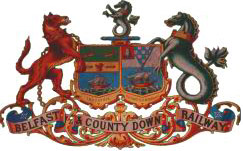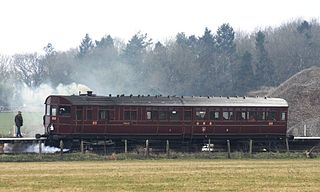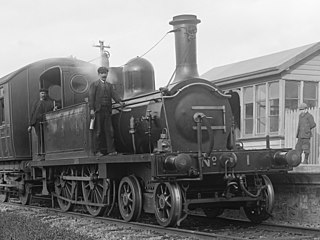
A steam railmotor or steam railcar is a carriage (railcar) that is self powered by a steam engine,

A steam railmotor or steam railcar is a carriage (railcar) that is self powered by a steam engine,
The Belfast and County Down Railway introduced three railmotors c.1905 which lasted in service until 1918. [1]
The Dublin, Wicklow and Wexford Railway had two steam railmotors, [2] built by Manning Wardle. [3]
The Great Northern Railway of Ireland operated seven steam railmotors acquired c.1906. [4]
The Great Southern and Western Railway purchased a single steam railmotor in 1905. [2]
Great Southern Railways initially introduced four steam railmotors, Nos. 354 to 357, from Sentinel in 1927 which were withdrawn in 1941–2. [5] These were followed by six from Clayton in 1928, which were relatively unsuccessful and withdrawn in 1932 though the carriage portions were converted into three articulated non-powered pairs which remained in service until 1955. [6]
The Northern Counties Committee obtained two new steam railmotors in 1905. [7]

The Belfast and County Down Railway (BCDR) was an Irish gauge railway in Ireland linking Belfast with County Down. It was built in the 19th century and absorbed into the Ulster Transport Authority in 1948. All but the line between Belfast and Bangor was closed in the 1950s, although some of it has been restored near Downpatrick by a heritage line, the Downpatrick and County Down Railway.

The Great Southern Railways Company was an Irish company that from 1925 until 1945 owned and operated all railways that lay wholly within the Irish Free State.
A wide variety of steam locomotives have been used on Ireland's railways. This page lists most if not all those that have been used in the Republic of Ireland and Northern Ireland. Irish railways generally followed British practice in locomotive design.
This is a bibliography for the history of rail transport in Ireland.

The GS&WR Class 201 was a class of ten 0-6-0T locomotives designed by Locomotive Engineer, Henry Ivatt in 1887 for shunting heavy goods trains at Kingsbridge and Cork yards. Although the design is generally attributed to Ivatt they were actually created in the last year of Alexander McDonnell's tenure. The locomotives were built in three batch with variations between batches: Nos. 207—210 were introduced in 1887; 201 and 202 followed in 1895 taking numbers formerly held by Sambo and Negro; while the final batch 214—217 emerged in 1901.

The GS&WR Class 101, classified as Class 101 or Class J15 by the Great Southern Railways, was a class of 0-6-0 steam locomotives designed for working goods traffic although they did, and were quite capable of, working branch and secondary passenger trains.
Railmotor is a term used in the United Kingdom and elsewhere for a railway lightweight railcar, usually consisting of a railway carriage with a steam traction unit, or a diesel or petrol engine, integrated into it.

The Great Northern Railway (Ireland) class S was a class of five 4-4-0 steam locomotive that the Great Northern Railway introduced in 1913 to haul Belfast – Dublin express passenger trains. They were followed two years later by the three similar class S2 locomotives.

The steam rail motors (SRM) were self-propelled carriages operated by the Great Western Railway in England and Wales from 1903 to 1935. They incorporated a steam locomotive within the body of the carriage.

A steam railcar is a rail vehicle that does not require a locomotive as it contains its own steam engine. The first steam railcar was an experimental unit designed and built in 1847 by James Samuel and William Bridges Adams. In 1848, they made the Fairfield steam carriage that they sold to the Bristol and Exeter Railway, who used it for two years on a branch line.

A steam railcar, steam motor car (US), or Railmotor (UK) is a railcar that is self powered by a steam engine. The first steam railcar was an experimental unit designed and built in 1847 by James Samuel and William Bridges Adams in Britain. In 1848 they made the Fairfield steam carriage that they sold to the Bristol & Exeter Railway, who used it for two years on a branch line.

The CSAR Railmotor of 1907 was a South African steam railmotor locomotive from the pre-Union era in Transvaal Colony.

The Cape Government Railways Railmotor of 1906 was a South African steam railmotor locomotive from the pre-Union era in the Cape of Good Hope.
The Great Southern and Western Railway (GS&WR) Class 351 initially consisted of four 0-6-0 tender locomotives designed by Robert Coey for use on heavy freight trains on the main line. They were joined by four similar locomotives built in 1912 introduced by Richard Maunsell, these had detail differences such as larger cabs and higher running plates. They included an extended smokebox to which a Phoenix superheater was briefly trialed but abandoned. They were initially designated GS&WR Class 249 but were subsequently grouped into class 351.

The Great Southern and Western Railway (GS&WR) Classes 301. 305, 309 and 321 consisted of 26 4-4-0 tender locomotives designed by Robert Coey for passenger work and built between 1900 and 1907.

Great Northern Railway Class BT were a class of 13 4-4-0T tank locomotives introduced by the GNR(I) from 1885.
Robert Coey (1851–1934) was a locomotive superintendent of the Great Southern and Western Railway (GS&WR) of Ireland from 1896 until 1911.
The GS&WR McDonnell 2-4-0 types were a set of passenger locomotive classes introduced on the Great Southern and Western Railway (GS&WR) of Ireland by its locomotive engineer Alexander McDonnell between about 1868 and 1877.

The Cork & Bandon 0-6-0 Beyer saddle tank was a class of five six-coupled locomotives supplied to the Cork and Bandon Railway (C&BR) between 1881 and 1894 by Beyer, Peacock & Company. They were, for a short while on introduction, to be the railway's principle motive power.
The Belfast and County Down (BCDR) 4-6-4 T were a class of four 6-coupled tank locomotives build by Beyer, Peacock & Company in 1920. Generally reliable and well-liked but with mediocre performance, they spent their lives on the Queen's Quay, Belfast to Bangor until withdrawal in the early 1950s. These were the only class of 4-6-4T wheel arrangement to work on Ireland’s broad gauge lines. The County Donegal Joint Railway Committee’s Class 4 used the same arrangement on narrow gauge.